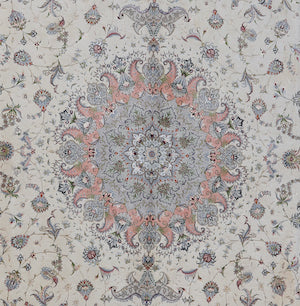Your Cart is Empty
2 min read
Tabriz is an ancient city in northwest Iran, located in the Azerbaijan province. Its history dates back to the 1st millennium BC, and it has served as the capital for various dynasties, with the Safavid dynasty being the last.
The designers and weavers of Tabriz carpets are renowned for their creativity and talent, as reflected in the diverse patterns and styles they produce. Centuries of cultural diversity and history have contributed to a remarkable collective memory among the local people. Such a rich cultural heritage often gives rise to mythical stories, beautiful poetry, splendid songs, and, most astonishingly, carpet motifs.
The carpet presented here exemplifies a magnificent creation that required over a year of work by three skilled and tasteful weavers, who meticulously wove 7.6 million knots to bring this fantastic rug to life. Achieving perfection, as seen in this rug, necessitated complete synchrony among all the workers, ensuring each knot was of the same size by maintaining the perfect dance-like harmony of speed, tension, and tightness of their hands.
However, the true mastermind behind the grandeur of this carpet is Master Benam, the designer. This rug is more than just a floor covering; it encapsulates the essence of a culture. It symbolises a quest and a journey in which humans seek ultimate perfection. That is why he has depicted the half-bloomed flowers and other design elements in a captivating order that resembles a movement, a dance towards the centre. The focal point of the rug features an exquisite, fully bloomed flower that symbolises perfection and a perfect form.
One of the most intriguing motifs within the medallion is the depiction of eight highly stylised and abstract forms of Simorgh, the legendary Persian Phoenix with open wings and flower-like heads, guarding the medallion.
The presence of this bird is widespread in Persian literature. It saves the legendary Zal and raises him to become the mighty Rostam's father, the greatest of Persian fighters. According to Shahnameh (970 AD), the Simorgh symbolises wisdom and healing powers. It is also mentioned in mystical literature by Avicenna (980-1037 AD) and in the scriptures of Zarathustra (1500 BC).
The magnificent combination of soothing colours and the intricate pattern of this rug attest to the incredible taste, creativity, and skill involved in its creation. Its profound cultural allure and captivating aesthetics make it a rug that adds a dimension of beauty to any room. This carpet serves as an object that could inspire one to explore Asian culture and the intermingling of great cultures, such as China and Iran, through the Silk Road, leaving their influences on each other's artistic endeavours. It ignites curiosity about the journey of the Phoenix from east to west or vice versa and, in the process, leads one to the conclusion that art and culture know no boundaries.

